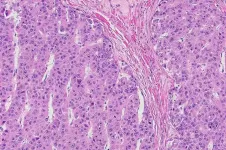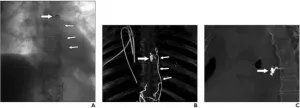(Press-News.org) Treatment options for a deadly liver cancer, fibrolamellar carcinoma, are severely lacking. Drugs that work on other liver cancers are not effective, and although progress has been made in identifying the specific genes involved in driving the growth of fibrolamellar tumors, these findings have yet to translate into any treatment. For now, surgery is the only option for those affected--mostly children and young adults with no prior liver conditions.
Sanford M. Simon and his group understood that patients dying of fibrolamellar could not afford to wait. "There are people who need therapy now," he says. So his group threw the kitchen sink at the problem and tested over 5,000 compounds, either already approved for other clinical uses or in clinical trials, to see whether any of the compounds could be repurposed to treat fibrolamellar. The team ultimately discovered a few classes of therapeutics that destroy fibrolamellar tumor cells growing in mice. Their findings are published in Cancer Discovery.
"We decided to be completely agnostic about what we thought would work--we tried everything," says Simon, head of the Laboratory of Cellular Biophysics. "To our surprise, we found a few compounds that work really well."
Faster drug discovery
In an ideal world, scientists perform extensive experiments to identify the perfect therapeutic target for a disease, then test a suite of drugs in model systems to pinpoint promising treatment options to hit the chosen target. The Simon lab is undergoing such experiments, but this process can take years, and the children and young adults who are sick now of fibrolamellar will likely never see the fruits of such labors.
So Simon took a parallel, expedited approach. After testing an extensive library of drugs on fibrolamellar tumor cells grown in mice over the course of several months, his team identified a few novel classes of therapeutics that appear to effectively kill fibrolamellar tumor cells, and further experiments provided some molecular explanations for why these drugs are so effective against a disease that has, until now, baffled physicians who treat liver cancer.
"Up to this point I've had to tell patients that we don't have any medicines that are proven to work," says Michael V. Ortiz, a pediatric oncologist at Memorial Sloan Kettering Cancer Center and a collaborator on the study. "It's really thrilling that we finally have some promising drugs to go after in clinical trials. And, since each individual responds differently, it's particularly exciting that we had multiple hits, which we can now test in combination with one another."
Treatment tailored for one
Building on these initial findings, Simon and his colleagues tested the compounds on human cells taken directly from patient tumors. They were able to test the cells against their lineup of drug candidates after growing them for only a few days, obtaining results similar to those observed in cells that took months to grow.
"Within three days, we can have therapeutically informative data, which is much faster than previous methods allowed," says Gadi Lalazar, an instructor in clinical investigation in the Simon laboratory and first author on the study. "Although there are some logistical hurdles and additional verification is needed, this could potentially be transformative for treating certain cancers."
The findings suggest that it may be unnecessary to screen new cancer drug candidates in cells grown in mice before testing them on human cells--an extra step that can cost cancer researchers many months. Given these results, physicians may soon be able to biopsy cells from a patient's tumor, subject those cells to a bevy of drug candidates until they find the most effective compound for that specific patient, and have a treatment plan ready in a matter of days--potentially transforming the landscape of precision medicine.
Advances in precision medicine
Simon's recent work was inspired by the 2015 precision medicine initiative begun in the Obama administration, which promised to change the face of medicine with a targeted approach, tailored to a patient's unique genetic composition, lifestyle, and environment.
"You don't want to give everyone with a limp the same treatment--you want it 'precisely targeted' based on whether they have twisted their ankle, broken a bone, or just have a splinter," says Simon.
Over the past six years, Simon has developed a series of model systems to help identify molecules known to drive cancers, known as oncogenes. But the key to applying precision medicine to cancer, Simon realized, is not blindly testing drugs against mutations or abnormally expressed genes--it's performing functional screenings that ask what drugs actually have an impact on the tumor in question.
The results of Simon's approach have now yielded the first therapeutics shown to eliminate fibrolamellar tumor cells, and new hope for people suffering from a deadly disease.
INFORMATION:
DALLAS - June 14, 2021 - Overweight cancer patients receiving immunotherapy treatments live more than twice as long as lighter patients, but only when dosing is weight-based, according to a study by cancer researchers at UT Southwestern Medical Center.
The findings, published in the Journal for ImmunoTherapy of Cancer, run counter to current practice trends, which favor fixed dosing, in which patients are given the same dose regardless of weight. The study included data on nearly 300 patients with melanoma, lung, kidney, and head and neck cancers ...
Leesburg, VA, June 14, 2021--According to ARRS' American Journal of Roentgenology (AJR), high-dose intranodal lymphangiography (INL) with ethiodized oil is a safe and effective procedure for treating high-output postsurgical chylothorax with chest tube removal in 83% of patients.
"To our knowledge," wrote corresponding author Geert Maleux of University Hospitals in Leuven, Belgium, "no data are available on the safety or potential beneficial effect of injecting higher doses of ethiodized oil to treat patients with refractory postoperative chylothorax."
All 18 patients (mean, 67 years; range, ...
A team of scientists from Kaunas University of Technology and Lithuanian Energy Institute proposed a method to convert lint-microfibers found in clothes dryers into energy. They not only constructed a pilot pyrolysis plant but also developed a mathematical model to calculate possible economic and environmental outcomes of the technology. Researchers estimate that by converting lint microfibers produced by 1 million people, almost 14 tons of oil, 21.5 tons of gas and nearly 10 tons of char could be produced.
Each year, the global population consumes approximately 80 billion pieces of clothing and approximately €140 million worth of it goes into landfill. This is accompanied by large amounts of emissions, causing serious environmental and health problems. One of the ways to lessen ...
A new study found higher education students are more engaged and motivated when they are taught using playful pedagogy rather than the traditional lecture-based method. The study was conducted by University of Colorado Denver counseling researcher Lisa Forbes and was published in the Journal of Teaching and Learning.
While many educators in higher education believe play is a method that is solely used for elementary education, Forbes argues that play is important in post-secondary education to enhance student learning outcomes.
Throughout the spring 2020 semester, Forbes observed students who were enrolled in three of her courses between the ages of 23-43. To introduce playful pedagogy, Forbes included games and play, not always tied to the ...
Solar flares jetting out from the sun and thunderstorms generated on Earth impact the planet's ionosphere in different ways, which have implications for the ability to conduct long range communications.
A team of researchers working with data collected by the Incoherent Scatter Radar (ISR) at the Arecibo Observatory, satellites, and lightning detectors in Puerto Rico have for the first time examined the simultaneous impacts of thunderstorms and solar flares on the ionospheric D-region (often referred to as the edge of space).
In the first of its kind analysis, the team determined that solar flares ...
The types of land around us play an important role in how major storms will unfold -- flood waters may travel differently over rural versus urban areas, for example. However, it's challenging to get an accurate picture of land types using only satellite image data because it is so difficult to interpret.
Researchers at the Cockrell School of Engineering have, for the first time, applied a machine learning algorithm to measure the surface roughness of different types of land with a high level of detail. The team used a type of satellite imagery that is more dependable and easier to capture than typical optical photographs but also more challenging to analyze. And they are working to integrate this data into storm surge models to give a clearer ...
Both during and after infection with the Coronavirus SARS-CoV-2, patients may suffer from severe neurological symptoms, including "anosmia", the loss of taste and smell typically associated with COVID-19. Along with direct damage caused by the virus, researchers suspect a role for excessive inflammatory responses in the disease. A team of researchers from the Freiburg University Medical Center and the Cluster of Excellence CIBSS has now shown that a severe inflammatory response can develop in the central nervous system of COVID-19 patients involving different immune cells around the vascular ...
Dr Sebastian Hess and his team at the University of Cologne's Institute of Zoology have studied a very rare and puzzling tripartite symbiosis. This consortium consists of a ciliate as host and two types of endosymbionts: a green alga and a previously unknown purple bacterium. Through genetic analyses of the pink-green ciliate, the researchers discovered that the endosymbiotic bacterium belongs to the so-called 'purple sulfur bacteria' (family Chromatiaceae), but has lost the ability to oxidize reduced sulfur compounds, a hallmark of the other members of the Chromatiaceae. The genome of the purple bacterium is greatly reduced, suggesting that the bacterium became mainly specialized in carbon fixation through photosynthesis. It is probably no longer able to live outside of the host cell. Thus, ...
Boston - Hypertension, or high blood pressure, kills more Americans than any other health condition. It is especially prevalent in Black Americans and is exacerbated by structural barriers to accessing high quality healthcare. In a 2018 randomized trial called the Los Angeles Barbershop Blood Pressure Study (LABBS), barbers were trained to screen their Black male patrons for hypertension and refer them to a pharmacist who visited the barbershop to counsel and treat individuals with high blood pressure. Participants in the barbershop-based, pharmacist-led program saw a 20-point drop in systolic (top number) blood pressure that they were able to sustain ...
An international research team led by Professor Dr Frank Schäbitz has published a climate reconstruction of the last 200,000 years for Ethiopia. This means that high-resolution data are now available for the period when early Homo sapiens, our ancestors, made their way from Africa to Europe and Asia. Schäbitz and his colleagues determined the dates using a drill core of lake sediments deposited in southern Ethiopia's Chew Bahir Basin, which lies near human fossil sites. Temporal resolution of the samples, reaching nearly 10 years, revealed that from 200,000 to 125,000 years before our ...




